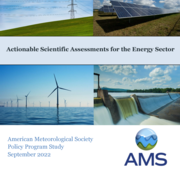Executive Summary
There is an innate and critical relationship between energy and weather, water, and climate (WWC). As the deployment of renewable energy, particularly wind and solar energy, increases, so too does dependence on weather and weather variability. Understanding, accounting for, and communicating weather and climate variables is therefore critical for the planning and optimization of the energy system—especially as the deployment of renewables will need to expand even more rapidly in the future in order to meet national goals. This puts increasing pressure on the scientific community, and particularly those working on the weather and climate aspects of renewables, to provide the right information to meet the key decision-making needs of the energy sector. Moreover, this information must be accessible and usable to those who need it—in other words, actionable.
This American Meteorological Society (AMS) Policy Program study is the second of two pilot projects on the provision of actionable information for decision-making through the tailored and targeted assessment of weather and climate science. Through conversations with professionals across the operational energy production and distribution sector as well as those from the WWC community, we identify seven key findings on the key decisions and information needs of the energy sector as they relate to weather and climate.
Findings:
- Effective development of wind, solar, and hydro power at the scales needed to foster a resilient and reliable renewable-based energy system will require accurate modeling of the availability of each resource. Some such datasets (such as an updated Wind Integration National Dataset [WIND] toolkit) are currently in development, but additional datasets are needed that fully merge solar capacity and wind potential in ways that allow for possible correlations or anticorrelations.
- There is a need for a comprehensive and continuously-updated high-resolution reanalysis dataset. This would ideally be at 1 km horizontal resolution with adequate boundary-layer vertical resolution to provide good hub-height wind data, and fully integrate not only meteorological data (with high-quality wind and solar capabilities) but also coincident energy data.
- Projections for how climate change will affect river basin runoff, wind and solar generating capacity in specific geographic regions, and weather extremes that impact generating infrastructure and distribution networks are still not sufficiently robust to allow confidence in long-term planning.
- Trustworthy and quality-controlled sources of data can be challenging for utilities to find and navigate, particularly when looking to visualize user-selected threshold-defined events. There is a need for a validated database that ties objective extreme events in the power infrastructure to the weather events that caused them so that projections of frequency changes in weather events can be used to project infrastructure impacts.
- Improved understanding of potential future conditions stemming from various impacts of climate change, especially changes in weather extremes, will be crucial to optimize the infrastructure needed for the generation and delivery of energy.
- While future energy generation will rely heavily on probabilistic forecast approaches, there is still much to be done to ensure the operational energy community is prepared to effectively utilize this information, as well as increasingly sophisticated measures of uncertainty in delivering firm power.
- While weather and climate information is crucial to deploying energy efficiently where it is needed, developing new regulatory and policy frameworks for energy delivery may be the most critical need at this time in allowing a larger penetration of renewables.
The transition to an efficient, resilient, and reliable energy system built primarily on renewables is an example of a “wicked” problem—inherently complex and uncertain with no optimal solution. As such, it necessitates bringing together a variety of stakeholders, sectors, and disciplines to develop multiple approaches to address the different components of the challenge in a comprehensive fashion. Actionable scientific assessments are useful mechanisms to aid the development of these approaches; they may not only reveal gaps in climate science knowledge but also the instances where these gaps might be bridged through the reframing of available information or through new convergence research.
This study confirmed that excellent progress is being made on a variety of fronts associated with renewable energy, from better understanding of turbine wakes to improve future wind farm siting to using artificial intelligence and machine learning (AI/ML) for better short-term forecasts of generation variabilities. Each of these areas of enhanced understanding and improved capabilities is critically important as we move to increase use of renewables. A consistent theme in the discussions under this study, however, is the need to bring together many disparate types of data, modeling, and analyses toward convergent tools that adequately address the complex interconnectedness of a national power system built on renewable sources. In many ways, the most significant finding of this study is the need for major convergence research efforts to build the necessary historical reanalysis datasets, integrated weather-energy forecast models, and policy and regulatory frameworks that can leverage current disciplinary research efforts.
Suggested Citation: Tipton, E. and K.L. Seitter 2022: Actionable Scientific Assessments for the Energy Sector. An AMS Policy Program Study. The American Meteorological Society, Washington, D.C. https://doi.org/10.1175/energy-sector-assessment-2022
